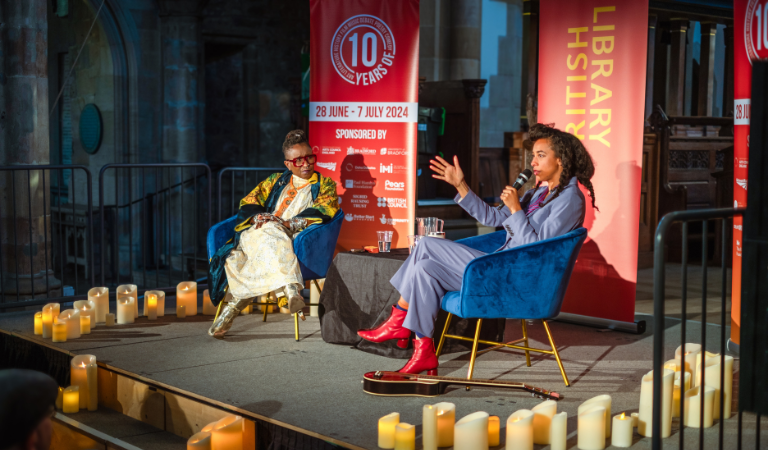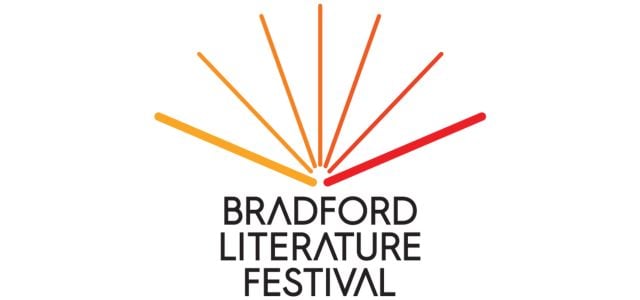A look back at The Stories Behind the Songs with Corinne Bailey Rae
Written by Jacob Gotobed

Fresh from performing at Glastonbury Festival, two-time Grammy-winner Corinne Bailey Rae, returned to Yorkshire for a special night at Bradford Literature Festival. Corinne Bailey Rae: The Stories Behind her Songs at the beautiful Bradford Cathedral, celebrated her latest project, Black Rainbows.
This event was co-produced with the British Library as part of Beyond the Bassline: 500 Years of Black British Music and chaired by Malika Booker; a British poet of Guyanese and Grenadian parentage and the founder of Malika’s Poetry Kitchen, who reminisced on listening to Bailey Rae’s debut album on CD back in 2006.

Malika Booker and Corinne Bailey Rae in Bradford Cathedral. Photography by Philip Lickley
The majestic Bradford Cathedral hosted a packed audience of intrigued music-lovers to hear about Black Rainbows, a collection of 10 songs reflecting on her time at the Stony Island Arts Bank in Chicago.
Bailey Rae felt empowered by the history she witnessed through the people, artists and objects she saw, in particular the Ed Williams Collection; “I was charmed by a statue of a boy [and the attention to detail], I felt sympathetic before I knew him and could see his humanity”. Bailey Rae then revealed that this statue was used as an ashtray, and highlighted the importance to tell the stories of these people and places rather than let them be lost or forgotten. “I felt provoked and challenged to make something new”.
Another influence for her was Audrey Smaltz, who was famously photographed as a young woman in fireman boots on the back of a fire truck. Bailey Rae explained how the archive gave her access to so many stories offering a sincere and important learning moment for the audience. And how Smaltz was the inspiration behind the track ‘New York Transit Queen’.
For the track Erasure, as Bailey Rae said “the objects felt like they had a job to tell me. Sometimes you couldn’t find any more information, so I imagined stories that were influenced by what happened.” Speaking of how important it was to ‘bridge the gap’ in her knowledge of Black History as traditional education doesn’t show the progress made, using slavery up to Martin Luther King as a timescale, when within that time things like Ebony and Jet magazine, and films like Hidden Figures helped highlight to her how Black people have thrived in some instances.

Corinne Bailey Rae discussing with Malika Booker at Bradford Cathedral, photography by Philip Lickley
Corinne Bailey Rae spoke about how she felt about changing the term of ‘Black History’ to be ‘History of Racism’, as she made the poignant comparison to a memory where she asked herself “does this look like my father’s feet?” when seeing lynching postcards for the first time in middle school.
She was commended by an audience member during the question-and-answer session on how elegantly she spoke on the subject. When asked about how the sounds of the album came to her, Bailey Rae responded by saying “I felt natural expressions of what the objects did to me. But a plethora of musical experiences at school and finding my small place in a big group [referencing being in an orchestra/ quartet], I was influenced by Kurt Kobain and Billie Holliday, this voice of texture gave her a place. I felt everything’s allowed.”
One audience member offered an important question, asking how to capitalise on their art without losing their spirit? Bailey Rae responded “You have to refuse to see yourself as a brand, you have to sense ‘what is art to you?’ And trust your instincts. Your gift speaks, keep that inner voice, you’ll know what’s for you. I’m inspired by new artists and original artists whether it’s dancers or poets, it allows for more music to come to you when you’re watching someone dance”. Ending the answer with “You have permission. There is freedom. There are no walls on what you can make and talk about. You have an authority, if the story comes to you or is you, or if it’s for you, that story wants to be told. It’s there for us all.”
Corinne Bailey Rae gave a compelling response when asked by an audience member about telling stories about places you’re not originally from, saying “I recognised my own story in the story of these people. As much as I am a person from the UK. I am also just kin, family and sibling of those taken from West Africa and taken across the world. They are separated in that moment and there’s personal connection when you have those stories in your ancestry. The pride of being a working-class person and then getting to go to university and doing well academically, I feel privileged because my parents or grandparents didn’t get to do this, I don’t feel like I’m saying I’m a British person going to America. I feel a part of a wider story.”
The Bradford Literature Festival event was rounded up by listening to ‘Peach Velvet Sky’ – inspired by Harriet Jacobs and her journey of what she had to face. Comparing her story to that of a Dickens novel “yet it’s real”. A beautiful opening piano sequence filled the cathedral, aptly matched by the sunset entering through the windows. This powerful fusion of jazz, gospel-like storytelling captivated the audience whilst telling a story.
Sometimes with music there can be a larger focus on the forefront, what you hear and how many records it will sell. But regardless of what genre of music you love, there’s something empowering and purposeful about the stories told behind these songs, Corinne Bailey Rae and Malika Booker gave audiences a profound message and understanding of why Black Rainbows was created, and why its crucial to share this history.

Corinne Bailey Rae and Malika Booker at Bradford Cathedral for Bradford Literature Festival 2024, photography by Philip Lickley
